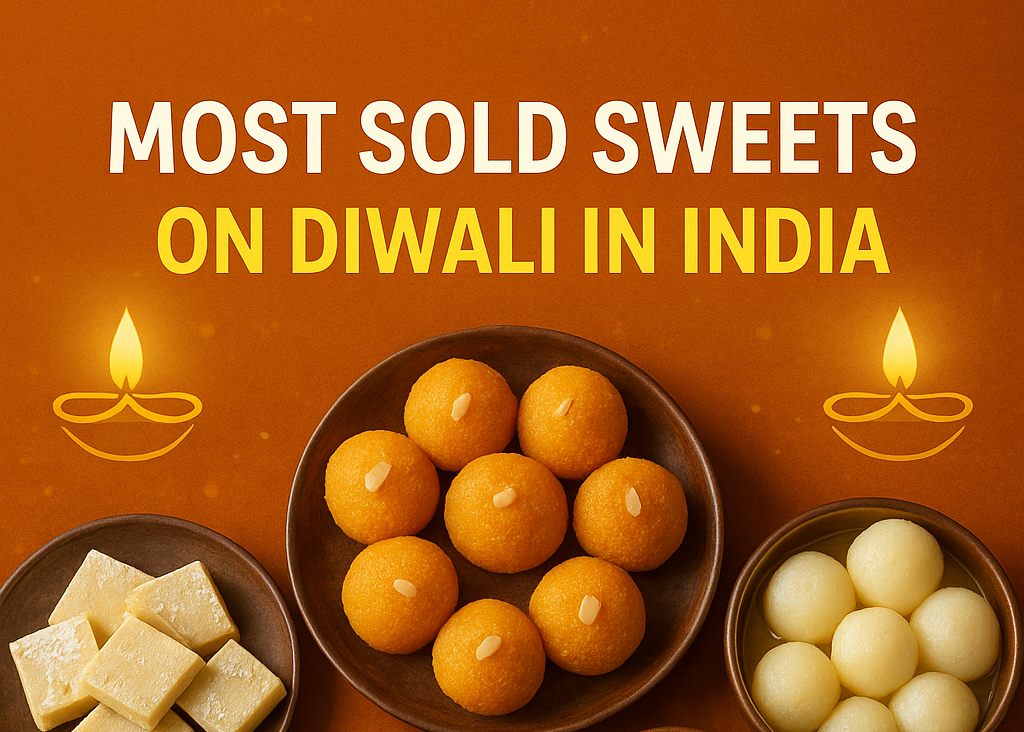Diwali, the festival of lights, is not just about diyas, decorations, and fireworks — it’s also a time when every home in India comes alive with the aroma of freshly made sweets. From traditional mithais that have been loved for generations to modern fusion desserts, the Indian sweet market sees its biggest boom during this season.
In fact, according to trade estimates, nearly 60–70% of India’s annual mithai sales happen around Diwali, as families exchange boxes of happiness and sweetness to celebrate prosperity and togetherness.

Let’s explore the most sold sweets on Diwali in India, the reasons behind their popularity, and the traditions that make each one special.
🪔 1. Ladoo – The Evergreen Symbol of Celebration
No Indian festival is complete without ladoo, and Diwali is no exception. Whether it’s Besan Ladoo, Motichoor Ladoo, or Boondi Ladoo, these round balls of joy are among the first to sell out at sweet shops.
Why It’s Popular:
- Symbolizes happiness, prosperity, and auspicious beginnings.
- Easy to store and share, making it perfect for gifting.
- Loved by all age groups for its soft texture and rich ghee flavor.
From North Indian households offering Motichoor Ladoo in puja thalis to South Indian homes preparing Rava Ladoo, this sweet unites the country in its golden glow.
🍡 2. Barfi – The Heart of Every Sweet Box
Barfi is one of the most versatile Indian sweets — available in endless varieties like Kaju Barfi (cashew), Pista Barfi (pistachio), Chocolate Barfi, and even fusion flavors like rose or mango. During Diwali, Kaju Katli tops the chart as one of the highest-selling sweets across India.
Why It’s Popular:
- Elegant diamond shape and silver leaf topping make it ideal for gifting.
- Premium ingredients like cashew and pista give it a luxurious touch.
- Long shelf life compared to syrup-based sweets.
Kaju Katli, in particular, is the Diwali favorite among corporate gift boxes and premium mithai brands.
🍯 3. Soan Papdi – The Light, Flaky Treat That Travels Everywhere
If there’s one sweet that has become synonymous with Diwali gifting, it’s Soan Papdi. Found in almost every home during the festive week, this sweet’s light, flaky texture and long shelf life make it a go-to for bulk gifting.
Why It’s Popular:
- Travel-friendly and stays fresh for weeks.
- Available in affordable packaging and attractive tins.
- Melts in your mouth with a hint of cardamom and ghee.
Whether it’s shared among neighbors or packed in Diwali hampers, Soan Papdi remains one of the most distributed sweets in India.
🧁 4. Gulab Jamun – The All-Time Favorite
Gulab Jamun is not just a sweet — it’s an emotion. These soft, syrup-soaked dumplings made of khoya or milk solids are always in high demand during Diwali.
Why It’s Popular:
- Rich, juicy, and indulgent — a festive must-have.
- Served warm or at room temperature, making it suitable for all occasions.
- Often made fresh at home, bringing families together in the kitchen.
Many sweet shops now offer mini gulab jamuns, stuffed jamuns, or even dry gulab jamuns for gifting purposes.
🧈 5. Rasgulla and Rajbhog – The Syrupy Delights from the East
The East Indian contribution to Diwali sweet boxes is incomplete without Rasgulla and its royal cousin Rajbhog. These spongy, syrupy balls of chhena are especially popular in metros and among Bengalis across India.
Why It’s Popular:
- Light and refreshing after a heavy festive meal.
- Symbol of purity and celebration in Bengali households.
- Available in attractive tin packs for gifting.
Modern brands have made these sweets travel-friendly, helping Rasgulla gain a pan-India fanbase during Diwali.
🍮 6. Kalakand – The Royal Sweet from Alwar
Kalakand, especially the famous Alwar Kalakand, has seen a massive rise in popularity across India during Diwali. Made from condensed milk and sugar, this sweet has a grainy texture and melt-in-mouth freshness that’s hard to resist.
Why It’s Popular:
- Authentic taste rooted in tradition.
- Made from pure milk, giving it a rich and wholesome flavor.
- Increasingly used as a premium gifting sweet due to its regional specialty.
Some modern brands like MishtiCue and others have started delivering authentic Alwar Kalakand across India, bringing the true taste of Rajasthan to every Diwali table.
🍫 7. Modern Fusion Sweets – The New-Age Trend
In recent years, Diwali has also seen a wave of fusion sweets — combining traditional flavors with modern presentations. Examples include:
- Chocolate Barfi
- Gulab Jamun Cheesecake
- Rabri Cupcakes
- Dry Fruit Modaks
These are particularly popular in urban India and among younger generations who want tradition with a twist.
🧺 Bonus: Dry Fruit Mixes and Sugar-Free Sweets
As health awareness grows, sugar-free mithais and dry fruit assortments have also become popular Diwali choices. Many brands now offer sugar-free Kaju Katli, low-calorie Ladoos, and date-based sweets that cater to modern dietary preferences.
Why It’s Popular:
- Perfect for gifting to elders and fitness-conscious friends.
- Longer shelf life and premium presentation.
- Packed beautifully in festive gift boxes.
🎁 The Tradition of Sweet Exchange: More Than Just Taste
Gifting sweets on Diwali is not just about sharing food — it’s about sharing blessings. Each mithai represents good fortune, health, and the sweetness of relationships. Whether it’s a box of homemade ladoos or a beautifully wrapped tin of soan papdi, every exchange carries emotion and love.
✨ Conclusion: Sweetness That Binds India Together
From the luxurious Kaju Katli to the humble Motichoor Ladoo, every sweet tells a story — of heritage, craftsmanship, and celebration. What makes Diwali truly special is not just the variety of sweets but the joy of sharing them with family, friends, and even strangers.
As you light up your home this Diwali, don’t forget to spread sweetness — because in every bite of mithai lies the real spirit of the festival.

